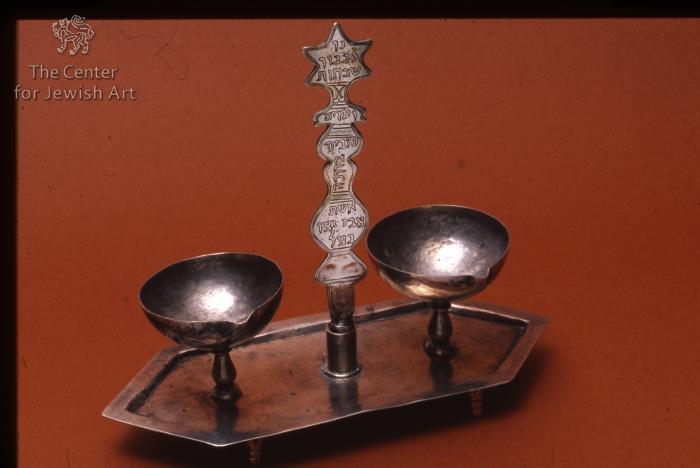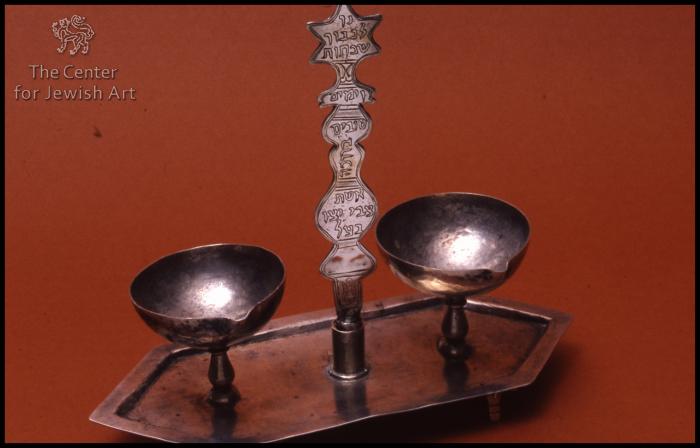Obj. ID: 23663 Sabbath lamp, Afghanistan, First half of the 20th century

© Center for Jewish Art, Photographer: Unknown,
sub-set tree:
Name/Title
Sabbath lamp | Unknown
Object
Object Detail
Date
First half of the 20th century
Synagogue active dates
Reconstruction dates
Artist/ Maker
Unknown (Unknown)
Origin
Historical Origin
Unknown
Community
Location
Unknown |
Site
Unknown
School/Style
Unknown|
Period
Period Detail
Gross Family Collection No.
CD5
Category
Material/Technique
Material Stucture
Material Decoration
Material Bonding
Material Inscription
Material Additions
Material Cloth
Material Lining
Tesserae Arrangement
Density
Colors
Construction material
Measurements
Height
Length
Width
Depth
Circumference
Thickness
Diameter
Weight
Axis
Panel Measurements
Hallmark
Iconographical Subject
Condition
Extant
Documented by CJA
Surveyed by CJA
Present Usage
Present Usage Details
Condition of Building Fabric
Architectural Significance type
Historical significance: Event/Period
Historical significance: Collective Memory/Folklore
Historical significance: Person
Architectural Significance: Style
Architectural Significance: Artistic Decoration
Urban significance
Significance Rating
Description
Custom
Contents
Codicology
Scribes
Script
Number of Lines
Ruling
Pricking
Quires
Catchwords
Hebrew Numeration
Blank Leaves
Direction/Location
Façade (main)
Endivances
Location of Torah Ark
Location of Apse
Location of Niche
Location of Reader's Desk
Location of Platform
Temp: Architecture Axis
Arrangement of Seats
Location of Women's Section
Direction Prayer
Direction Toward Jerusalem
Signature
Colophon
Scribal Notes
Watermark
Binding
Decoration Program
Summary and Remarks
History/Provenance
As everywhere in the Jewish world, the Sabbath is introduced by the kindling of lights. According to a tradition known to us from Talmudic times, an oil lamp was lit. The early Persian oil lamps, and the more recent lamps used for lighting homes in this region of the Orient, generally consisted of a vessel made of clay, glass, or metal within which the wick floated in the oil.
A typical Afghan Sabbath lamp is a concave silver vessel with decorated borders, mounted on a shaft that stands in the center of a three or four-legged flat base with raised borders. Protruding from the front of the vessel are two spouts, alluding to the double invocation of the commandment: "Remember the Sabbath day. to keep it holy" (Ex. 20:8) and "Keep the Sabbath day to sanctify it" (Deut. 5:12). Similar Sabbath lamps were still in use at the beginning of the twentieth century.
Later, two separate vessels replaced the two spouts, and each wick burned in its separate container. Eventually, a pair of candle holders, intended for wax candles, were added, one on each side of the base.
According to tradition, the women of the Afghan community took great pains to spin the wicks out of cotton or linen, making sure that the number of threads in the wick corresponded to the number of men reading from the Torah on that particular holy day. Thus, on the Sabbath the wick was twisted out of seven threads, on Yom Kippur - six, on other festivals - five, and on intermediate days (Hol Hamo'ed) and New Moon (Rosh Hodesh) the wick consisted of four threads.
Main Surveys & Excavations
Bibliography
Hanegbi, Zohar and Bracha Yaniv, Afghanistan : the synagogue and the Jewish home (Jerusalem: Center for Jewish Art, 1991), pp. 28-29, 143-144.
Short Name
Full Name
Volume
Page
Type
Documenter
|
Researcher
|
Architectural Drawings
|
Computer Reconsdivuction
|
Section Head
|
Language Editor
|
Donor
|
Object Copyright
Gross Family Collection (GFC)



